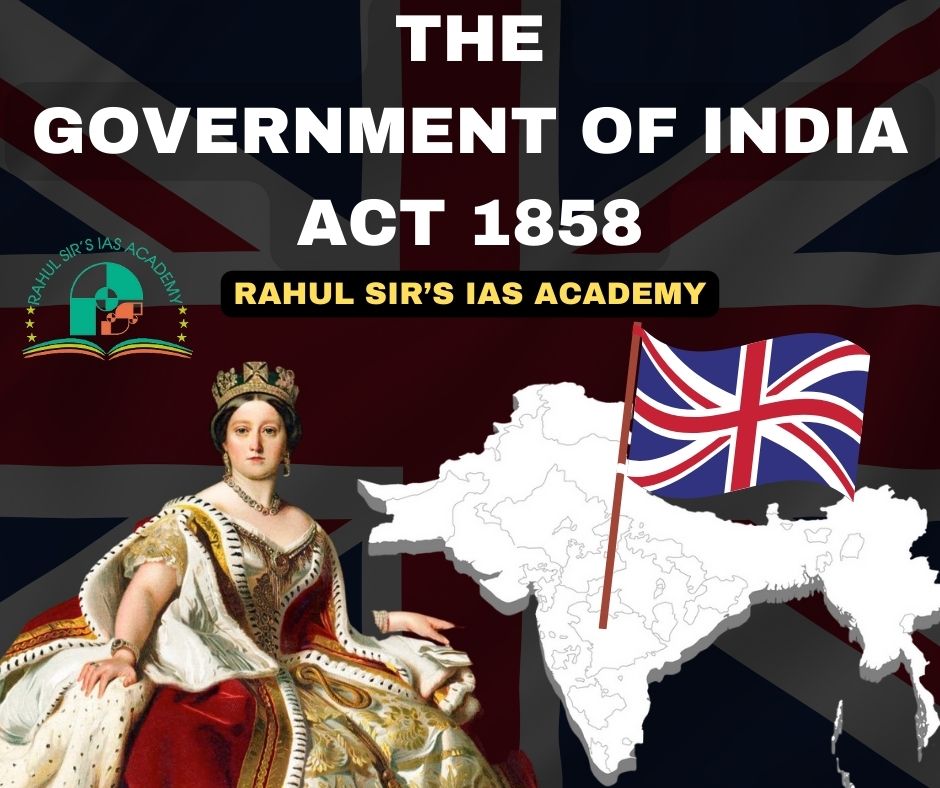
Government Of India Act 1858 – Introduction

The Government of India Act 1858 marked a turning point not only for the British rule in India but also for the Constitutional development in India. Turning point for British rule, because now the entire Indian administration was transferred to the British Crown from the hands of the East India Company. The primary reason for the transfer was the Revolt of 1857, which according to the British government occurred due to the ineptitude of the East India Company in handling Indian affairs.
Initially the bill pertaining to transfer of Indian administration to the British Crown was introduced by Lord Palmerston, the then Prime Minister. Lord Palmerston was forced to resign from the office on some other issue, so the bill could not pass in the Parliament. Later Lord Edward Stanley who went to become the first Secretary of States for India introduced another bill originally titled “An Act for the Better Governance of India”. The bill was passed on 2nd August 1858 just 2 months after Lord Canning announced victory over the Revolt of 1857.
The bill after becoming the act came to be known as the Government of India Act 1858. Since then India was to be directly governed under the name of the Crown. This was conspicuously different from the previous acts passed in the British Parliament namely – Regulating Act 1773, Pitt’s India Act 1784, Charter Acts of 1813, 1833 and 1853.
Key Provisions of Government Of India Act 1858
- The most outstanding feature of Government of India Act 1858 was the liquidation of East India Company. Henceforth all Indian territories would be directly governed by the Crown.
- The Board of Control and the Court of Directors was abolished and all their powers, duties and functions were vested with the Secretary of State for India. Accordingly the first Secretary of State was Lord Stanley.
- According to the Government of India Act 1858, the Secretary of State was to be a Cabinet rank minister and would be assisted by a 15 member ‘India Council’. India Council was to have 8 members nominated by the Crown and 7 members from the former Court of Directors.
- The Governor General of India was to report to the Secretary of State. Thus his office was a prime medium of communication between the Indian administration and the British government.
- The Secretary of State was also empowered to send secret despatches to India without consulting the India Council.
- The Secretary of State was answerable to the Parliament for the state of affairs in India.
More
- Prime Minister Palmerson had alleged that the primary defects of the Company’s rule were due the cumbersome, complex and irrational nature of the dual government. Thus the system of Dual Government as envisaged in the Pitt’s India Act 1884 was scrapped.
- The Governor General of India would henceforth be called Viceroy as now he represented the Queen. Thus the first Viceroy of India was Lord Canning.
- From now onwards the Viceroy and the Governors of Provinces would be appointed by the Crown.
- The policy of annexations was abandoned and the much criticized policy of Doctrine Of Lapse introduced by Lord Dalhousie was put to rest.
- The act provided that the remaining Princely States numbering more than 560 would have an independent status as long as they accepted British suzerainty.
- The Government of India Act 1858 allowed Indians to appear in the Civil Services Examination held in London. With this, Satyendranath Tagore the uncle of Rabindranath Tagore became the first Indian to pass the exam in the 1860s.
- It was decided under this act that the participants of the Revolt of 1857 would be pardoned except those who killed British subjects.
- The Queen’s proclamation vowed for a perpetual support to the native princes and non intervention in the religious beliefs of Indians.
Government of India Act 1858 – Defects
- With the passing of this act, there ushered in a new era of despotic rule in India that lasted till 15th August 1947. According to Charles Wood – “In a situation where a superior race rules over others the mildest form of government is despotism”.
- The Indian opinion suffered further alienation as the controlling power center of India was shifted thousands of miles away.
- The supreme authority i.e. the Secretary of State was answerable to the British Parliament and not to the Indian people.
Drawbacks Of Government Of India Act 1858
The Government of India Act of 1858, often referred to as the Act for the Good Government of India, was a significant piece of legislation. This Act marked the end of the rule of the East India Company. It transferred the governance of India directly to the British Crown. While it brought about several changes, it also had some drawbacks:
- Continued British Control: The Act did not introduce democratic governance or provide meaningful representation for Indians in the administration of their own country. Instead, it maintained British control over India and placed ultimate authority in the hands of the British Crown.
- Lack of Indian Participation: The Act did not include provisions for Indian participation in the highest levels of government. While it allowed for some Indian representation in legislative councils, these councils had limited powers, and real decision-making authority remained with British officials.
- Limited Provincial Autonomy: The Act established a centralized system of governance with the Viceroy and Governors-General exercising significant powers. It did not grant sufficient autonomy to the provinces, which could have better addressed local needs and concerns.
- Ignoring Cultural and Regional Diversity: The Act did not take into account the vast cultural, linguistic, and regional diversity of India. It imposed a uniform system of governance that did not adequately respect or accommodate the various customs, traditions, and languages of the Indian subcontinent.
More
- Lack of Comprehensive Social Reforms: While the Act aimed at maintaining law and order, it did not prioritize comprehensive social and economic reforms. Issues such as land reforms, caste discrimination, and the welfare of marginalized communities were largely ignored.
- Limited Progress in Education: While the Act did allocate some funds for education, it did not have a comprehensive plan for its promotion. Education and literacy among the Indian population was not given much emphasis. Education remained limited to the elite, and primary education was neglected.
- Economic Exploitation: The Act continued to allow the British government to extract revenue from India. This often resulted in economic exploitation and hardship for the Indian population. The economic interests of Britain took precedence over the development of India’s economy.
- Neglect of Indian Civil Services: The Act did not address the need for Indianization of the civil services. The Indian Civil Service (ICS) continued to be dominated by British officials, perpetuating a lack of understanding of local issues and cultures.
- No Consideration of Religious and Communal Tensions: The Act did not address the rising religious and communal tensions in India. It did not provide mechanisms for resolving conflicts or promoting interfaith harmony.
Impact of Government of India Act 1858
- The government stopped interfering in socio-religious matters. It took almost 35 years after the Hindu Widow Remarriage Act 1856, for a new social legislation in the form of the Age of Consent Bill in 1892 that sought to increase the marriage age of girls from 10 to 16.
- Henceforth the Britons tried to remain as aloof as possible from the native contamination in their private clubs and well guarded cantonments.
- British contacts with Indian society diminished as now very few British men consorted with Indian women.
- Earlier the British used to sympathize with Indian life and culture. This attitude was now replaced with suspicion, indifference and fear.
- The strength of British soldiers in the army was increased. This aggravated the racial arrogance.
- From 1858 onwards the Indian administration was run by the world’s largest imperial bureaucracy with a highly centralized despotic rule.
- The Viceroy’s executive council became a miniature cabinet with a portfolio system. Each member was assigned one of the 5 portfolios (home, revenue, military, finance, and law). The Commander in Chief sat as the 6th extraordinary member.
More
- In 1874 a sixth ordinary member was added to head the Public Works Department. In 1904, the department’s name was changed to Commerce and Industry.
- The foreign department was personally handled by the Viceroy which was responsible for relations with the Princely States and neighboring countries.
- The cost incurred to curb the 1857 mutiny was equivalent to one year’s revenue. This was recovered by enhanced taxation in the next 4 years.
- The railway network was rapidly expanded which gave mixed blessings to both Indians and British.
- Post 1858, the Indian economy got more and more linked to the international economy. It thus got exposed to the fluctuations of world markets. The Indian peasantry was the worst sufferers of this phenomenon.
Conclusion
The Government of India Act of 1858 was a significant step in the process of the British government’s control over India, and it marked the end of the East India Company’s rule in India. It established a new system of governance in India, known as the “British Raj” that lasted till 15th August 1947. By the Government of India Act 1858, the British government was given complete control over the administration of India. Also it provided for the establishment of a new administrative structure, legal system, education and training of civil servants. This act also created the office of Viceroy of India, who would be appointed by the British Crown. He would act as the representative of the British Monarch in India. The act was a major step towards modernizing the administration of India and making it more effective.
Although the office of Secretary of State was held by some of the most powerful politicians, the real effective power lay with the Viceroy who divided his time between Calcutta and Shimla.
Later in 1876, on the prompting of Prime Minister Benjamin Disraeli, the Queen was given an additional title ‘Empress of India’.
See Also
Maharaja Ranjit Singh – Conquests, Wives and More
Tipu Sultan – History, Wars, Palace, Sword, Fort and Mosque
FAQs
The main result of the Government of India Act was that Indian voice got further alienated because the effective controls of Indian administration moved thousands of miles away to London.
There is no specific name to this act but when it was introduced in the British Parliament it was called “An Act for the Better Governance of India”.

